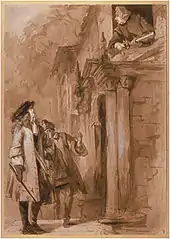Trickster
In mythology and the study of folklore and religion, a trickster is a character in a story (god, goddess, spirit, human or anthropomorphisation) who exhibits a great degree of intellect or secret knowledge and uses it to play tricks or otherwise disobey normal rules and defy conventional behavior.

Mythology
Tricksters, as archetypal characters, appear in the myths of many different cultures. Lewis Hyde describes the trickster as a "boundary-crosser".[1] The trickster crosses and often breaks both physical and societal rules: Tricksters "violate principles of social and natural order, playfully disrupting normal life and then re-establishing it on a new basis."[2]
Often, this bending or breaking of rules takes the form of tricks or thievery. Tricksters can be cunning or foolish or both. The trickster openly questions, disrupts or mocks authority.
Many cultures have tales of the trickster, a crafty being who uses tricks to get food, steal precious possessions, or simply cause mischief. In some Greek myths Hermes plays the trickster. He is the patron of thieves and the inventor of lying, a gift he passed on to Autolycus, who in turn passed it on to Odysseus.[1] In Slavic folktales, the trickster and the culture hero are often combined.
Frequently the trickster figure exhibits gender and form variability. In Norse mythology the mischief-maker is Loki, who is also a shapeshifter. Loki also exhibits sex variability, in one case even becoming pregnant. He becomes a mare who later gives birth to Odin's eight-legged horse Sleipnir.
In African-American folklore, a personified rabbit, known as Brer Rabbit, is the main trickster figure.[3] In West Africa (and thence into the Caribbean via the slave trade), the spider (see Anansi) is often the trickster.[4] In southern African a ǀKaggen is often the trickster, usually taking the form of a praying mantis.[5][6]
Trickster or clown
The trickster is a term used for a non-performing "trick maker"; they may have many motives behind their intention but those motives are not largely in public view. They are internal to the character or person.
The clown on the other hand is a persona of a performer who intentionally displays their actions in public for an audience.
In Native American tradition
While the trickster crosses various cultural traditions, there are significant differences between tricksters in the traditions of different parts of the world:
Many native traditions held clowns and tricksters as essential to any contact with the sacred. People could not pray until they had laughed, because laughter opens and frees from rigid preconception. Humans had to have tricksters within the most sacred ceremonies for fear that they forget the sacred comes through upset, reversal, surprise. The trickster in most native traditions is essential to creation, to birth.[7]
Native American tricksters should not be confused with the European fictional picaro. One of the most important distinctions is that "we can see in the Native American trickster an openness to life's multiplicity and paradoxes largely missing in the modern Euro-American moral tradition".[8] In some stories the Native American trickster is foolish and other times wise. He can be a hero in one tale and a villain in the next.
In many Native American and First Nations mythologies, the Coyote spirit (Southwestern United States) or Raven spirit (Pacific Northwest) stole fire from the gods (stars, moon, and/or sun). Both are usually seen as jokesters and pranksters. In Native American creation stories, when Coyote teaches humans how to catch salmon, he makes the first fish weir out of logs and branches.[1]
Wakdjunga in Winnebago mythology is an example of the trickster archetype.
Wisakedjak (Wìsakedjàk in Algonquin, Wīsahkēcāhk(w) in Cree and Wiisagejaak in Oji-Cree) is a trickster figure in Algonquin and Chipewyan Storytelling.
Coyote

The Coyote mythos is one of the most popular among western Native American cultures, especially among indigenous peoples of California and the Great Basin.
According to Crow (and other Plains) tradition, Old Man Coyote impersonates the Creator: "Old Man Coyote took up a handful of mud and out of it made people".[9] He also bestowed names on buffalo, deer, elk, antelopes, and bear. According to A. Hultkranz, the impersonation of Coyote as Creator is a result of a taboo, a mythic substitute to the religious notion of the Great Spirit whose name was too dangerous and/or sacred to use apart from at special ceremonies.
In Chelan myths, Coyote belongs to the animal people but he is at the same time "a power just like the Creator, the head of all the creatures." while still being a subject of the Creator who can punish him or remove his powers.[10] In the Pacific Northwest tradition, Coyote is mostly mentioned as a messenger, or minor power.
As the culture hero, Coyote appears in various mythic traditions, but generally with the same magical powers of transformation, resurrection, and "medicine". He is engaged in changing the ways of rivers, creating new landscapes and getting sacred things for people. Of mention is the tradition of Coyote fighting against monsters. According to Wasco tradition, Coyote was the hero to fight and kill Thunderbird, the killer of people, but he could do that not because of his personal power, but due to the help of the Spirit Chief. In some stories, Multnomah Falls came to be by Coyote's efforts; in others, it is done by Raven.
More often than not Coyote is a trickster, but always different. In some stories, he is a noble trickster: "Coyote takes water from the Frog people... because it is not right that one people have all the water." In others, he is malicious: "Coyote determined to bring harm to Duck. He took Duck's wife and children, whom he treated badly."
In oral stories

- Abenaki mythology: Azeban
- Igbo folklore: Ekwensu
- Afro-Cuban mythology: Eleggua, Eshu
- Akan mythology: Kwaku Ananse
- American folklore of African origin: Brer Rabbit (compare Compère Lapin in the French-speaking Caribbean)
- * from a separate African origin Aunt Nancy, a corruption of Anansi, also spelt 'Anansee', among other spellings
- Arabian mythology: Juha, Sinbad
- Ashanti folklore: Anansi
- Australian Aboriginal mythology: Bamapana, Crow
- Aztec mythology: Huehuecoyotl
- Babylonian mythology: Lilith
- Bantu mythology: Hare (Tsuro or Kalulu)
- Basque mythology: San Martin Txiki
- Belgian mythology: Lange Wapper
- Brazilian folklore: Saci, Curupira
- Bulgarian/Macedonian folklore: Hitar Petar (Itar Pejo)
- Caribbean folklore: Anansi
- Celtic mythology: Fairy, Puck, puca
- Chinese mythology: Huli jing (Fox spirit), Nezha, Red Boy, Sun Wukong (Monkey King)
- Chukchi mythology: Kutkh
- Cree mythology: Wisakedjak
- Crow mythology: Awakkule, Mannegishi
- Dutch folklore: Reynaert de Vos, Tijl Uilenspiegel
- Egyptian mythology: Set, Isis
- English folklore: Robin Hood, Puck, Brownies
- Fijian mythology: Daucina
- French folklore: Renart the Fox
- German folklore: Reineke Fuchs, the Pied Piper, Till Eulenspiegel
- Greek mythology: Eris, Prometheus, Hermes, Odysseus, Sisyphus, Dolos
- Haitian folklore: Anansi, Ti Malice
- Hawaiian mythology: Kaulu, Kupua
- Hindu mythology: Baby Krishna (stealing butter), Narada, Mohini, Hanuman (shapeshifting and teasing sages).
- Hopi and Zuni mythology: Kokopelli
- Igbo mythology: Mbeku
- Indonesian folklore: Kantjil, or kancil in modern orthography
- Inuit mythology: Amaguq
- Irish folklore: Leprechauns, Briccriu
- Islamic mythology: Iblis, Khidr, Nasreddin
- Italian folklore: Giufà (Sicily), Pulcinella (Naples)
- Japanese mythology: Kitsune, Susanoo, Kappa, Bake-danuki, Hare of Inaba
- Jewish folklore: Hershele Ostropoler (Ashkenazi), Joha (Sephardic)
- Kazakh folklore: Aldar kose
- Kiowa folklore: Saynday
- Korean folklore: Kumiho, Dokkaebi, Seokga
- Lakota mythology: Iktomi, Heyoka
- Latin American and Spanish folklore: Pedro Urdemales (Pedro Malasartes in Portuguese)
- Levantine mythology: Yaw
- Māori mythology: Māui
- Mayan mythology: Maya Hero Twins, Kisin
- Micronesian mythology: Olifat
- Miwok mythology: Coyote
- Nigerian mythology: Agadzagadza
- Norse mythology: Loki
- Norwegian mythology: Espen Askeladd
- Northwest Caucasian mythology: Sosruko
- Ohlone mythology: Coyote
- Ojibwe mythology: Nanabozho
- Philippine mythology: Nuno sa Punso, Tikbalang, Pilandok
- Polynesian mythology: Maui
- Pomo mythology: Coyote
- Pueblos dancing: Koshares
- Romanian mythology: Păcală
- Russian folklore: Ivan the Fool
- San Folklore: ǀKaggen
- Slavic mythology: Veles
- Spanish mythology: Don Juan, The Trickster of Seville
- Sumerian religion: Enki
- Tibetan folklore: Akhu Tönpa,
- Thai folklore: Sri Thanonchai
- Tumbuka mythology: Kalulu
- Ute mythology: Cin-an-ev
- Vietnamese folklore: Trạng Quỳnh, Bang Bạnh - Xã Xệ - Lý Toét, Thằng Bờm, Cuội, Bác Ba Phi
- Vodou: Papa Legba, Ti Malice, Baron Samedi
- Welsh mythology: Gwydion, Taliesin, Morgan Le Fay, Twm Siôn Cati[11]
- West African mythology: Anansi
- Yoruba religion: Eshu
In literature and popular culture
In modern literature, the trickster survives as a character archetype, not necessarily supernatural or divine, sometimes no more than a stock character.
Often, the trickster is distinct in a story by their acting as a sort of catalyst; their antics are the cause of other characters' discomfiture, but they are left untouched. Shakespeare's Puck is an example of this. Another once-famous example was the character Froggy the Gremlin on the early USA children's television show "Andy's Gang". A cigar-puffing puppet, Froggy induced the adult humans around him to engage in ridiculous and self-destructive hi-jinks.[12]
For example, many European fairy tales have a king who wants to find the best groom for his daughter by ordering several trials. No brave and valiant prince or knight manages to win them, until a poor and simple peasant comes. With the help of his wits and cleverness, instead of fighting, they evade or fool monsters, villains and dangers in unorthodox ways. Against expectations, the most unlikely candidate passes the trials and receives the reward.
More modern and obvious examples of the same type include Bugs Bunny in the USA and from Sweden the female hero in the Pippi Longstocking stories.
In Internet and multimedia studies
In online environments, there has been a link between the trickster and Internet trolling. Some have said that a trickster is a type of online community character.[13][14]
Anthropologist James Cuffe has called the Chinese internet character Grass Mud Horse (草泥马) a trickster candidate because of its duplicity in meaning.[15] Cuffe argues the Grass Mud Horse serves to highlight the creative potential of the trickster archetype in communicating experiential understanding through symbolic narrative. The Grass Mud Horse relies on the interpretative capacity of storytelling in order to skirt internet censorship while simultaneously commenting on the experience of censorship in China. In this sense Cuffe proposes the Grass Mud Horse trickster as 'a heuristic cultural function to aid the perceiver to re-evaluate their own experiential understanding against that of their communities. By framing itself against and in spite of limits the trickster offers new coordinates by which one can reassess and judges one's own experiences.'[15]
See also
References
- Hyde, Lewis. Trickster Makes This World: Mischief, Myth, and Art. New York: Farrar, Straus and Giroux, 1998.
- Mattick, Paul (February 15, 1998). "Hotfoots of the Gods". New York Times.
- Baker, Houston A. (1972). Long Black Song: Essays in Black American Literature. University Press of Virginia. pp. 10–14. ISBN 9780813904030.
- Haase, Donald (2008). The Greenwood Encyclopedia of Folktales and Fairy Tales. Greenwood Publishing Group. pp. 31. ISBN 978-0-313-33441-2.
- Bleek (1875) A brief account of Bushman folklore and other texts
- Lewis‐Williams, David (1997). "The mantis, the eland and the meerkats". African Studies. 56 (2): 195-216. doi:10.1080/00020189708707875.
- Byrd Gibbens, Professor of English at University of Arkansas at Little Rock; quoted epigraph in Napalm and Silly Putty by George Carlin, 2001
- Ballinger (1991), p. 21.
- "Gold Fever California on the Eve- California Indians", Oakland Museum of California
- Edmonds, Margot; Ella E. Clark (2003). Voices of the Winds: Native American Legends. Castle Books. p. 5. ISBN 0785817166.
- Carradice, Phil (16 June 2011). "Twm Sion Cati - the Welsh Robin Hood". bbc.co.uk. Retrieved 18 March 2021.
- Smith, R. L. "Remembering Andy Devine".
- Campbell, J., G. Fletcher & A. Greenhill (2002). "Tribalism, Conflict and Shape-shifting Identities in Online Communities." In the Proceedings of the 13th Australasia Conference on Information Systems, Melbourne Australia, 7–9 December 2002.
- Campbell, J., G. Fletcher and A. Greenhill (2009). "Conflict and Identity Shape Shifting in an Online Financial Community", Information Systems Journal (19:5), pp. 461–478. doi:10.1111/j.1365-2575.2008.00301.x.
- Cuffe, James B. (2019-11-28). China at a Threshold: Exploring Social Change in Techno-Social Systems (1 ed.). Abingdon, Oxon ; New York, NY: Routledge, 2020. | Series: Contemporary liminality: Routledge. pp. 83 [71–86]. doi:10.4324/9781315183220. ISBN 978-1-315-18322-0. S2CID 213224963.
{{cite book}}: CS1 maint: location (link)
Sources
- Gates, Henry (2004), Julie Rivkin; Michael Ryan (eds.), "The Blackness of Blackness: A Critique on the Sign and the Signifying Monkey", Literary Theory: An Anthology, Oxford: Blackwell Publishing
- Earl, Riggins R. Jr. (1993). Dark Symbols, Obscure Signs: God, Self, And Community In The Slave Mind. Maryknoll, New York: Orbis Books.
- Bassil-Morozow, Helena (2011). The Trickster in Contemporary Film. Routledge.
- Ballinger, Franchot; Vizenor, Gerald (1985). "Sacred Reversals: Trickster in Gerald Vizenor's 'Earthdivers: Tribal Narratives on Mixed Descent'". American Indian Quarterly. 9 (1, The Literary Achievements of Gerald Vizenor): 55–59. doi:10.2307/1184653. JSTOR 1184653.
- Ballinger, Franchot (1991). "Ambigere: The Euro-American Picaro and the Native American Trickster". MELUS. 17 (1, Native American Fiction: Myth and Criticism): 21–38. doi:10.2307/467321. JSTOR 467321.
- Boyer, L. Bryce; Boyer, Ruth M. (1983). "The Sacred Clown of the Chiricahua and Mescalero Apaches: Additional Data". Western Folklore. 42 (1): 46–54. doi:10.2307/1499465. JSTOR 1499465.
- Datlow, Ellen and Terri Windling. 2009. The Coyote Road: Trickster Tales. Firebird.
- California on the Eve - California Indians Miwok creation story
- Joseph Durwin Coulrophobia & The Trickster
- Koepping, Klaus-Peter (1985). "Absurdity and Hidden Truth: Cunning Intelligence and Grotesque Body Images as Manifestations of the Trickster". History of Religions. 24 (3): 191–214. doi:10.1086/462997. JSTOR 1062254. S2CID 162313598.
- Lori Landay Madcaps, Screwballs, and Con Women: The Female Trickster in American Culture 1998 University of Pennsylvania Press
- Paul Radin The trickster: a study in American Indian mythology (1956)
- Allan J. Ryan The Trickster Shift: Humour and irony in contemporary native art 1999 Univ of Washington ISBN 0-7748-0704-0
- Trickster's Way Volume 3, Issue 1 2004 Article 3 "Trickster and the Treks of History".
- Tannen, R. S., The Female Trickster: PostModern and Post-Jungian Perspectives on Women in Contemporary Culture, Routledge, 2007

